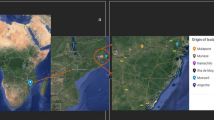Abstract
Tropical cowpea rhizobia are often presumed to be generally promiscuous but poor N fixers. This study was conducted to evaluate symbiotic interactions of 59 indigenous rhizobia isolates (49 of them from cowpea (Vigna unguiculata)), with up to 13 other (mostly tropical) legume species. Host ranges averaged 2.4 and 2.3 legume species each for fast- and slow-growing isolates respectively compared to 4.3 for slow-growing reference cowpea strains. An average of 22% and 19% of fast- and slow-growing cowpea isolates respectively were effective on each of 12 legume species tested. We conclude that the indigenous cowpea rhizobia studied have relatively narrow host ranges. The ready nodulation of different legumes in tropical soils appears due to the diversity of indigenous symbiotic genotypes, each consisting of subgroups compatible with a limited number of legume species.
Similar content being viewed by others
References
Graham P H, Sadowsky M J, Keyser H H, Barnet Y M, Bradley R S, Cooper J E, De Ley D J, Jarvis B D W, Roslycky E B, Strijdom B W and Young J P W 1991 Proposed minimal standards for the description of new genera and species of root-and stem-modulating bacteria. Int. J. Syst. Bacteriol. 41, 582–587.
Lie T A, Goktan D, Engin M, Pijnenborg J and Anlarsal E 1987 Co-evolution of the legume-Rhizobium association. Plant and Soil 100, 171–181.
Marufu L, Karanja N and Ryder M 1995 Legume inoculant production and use in East and Southern Africa. Soil Biol. Biochem. 27, 735–738.
McClure P R and Israel D W 1979 Transport of nitrogen in the xylem of soybean plants. Plant Physiol. 64, 411–416.
Mpepereki S 1994 Characterization studies of rhizobia in some Zimbabwean soils. Ph.D. Thesis. University of Zimbabwe, Harare, Zimbabwe.
Mpepereki S and Makonese F 1994 Inoculation response of cowpea (Vigna unguiculata [L.]) soyabean (Glycine max [L.] Merr.) and dry bean (Phaseolus vulgaris [L.]) in soils with low populations of rhizobia. In Recent Developments in Nitrogen Fixation Research in Africa. Eds. M Sadiki and A Hilali. pp 32–44. IAV Hassan II, Rabat, Morocco.
Mpepereki S, Wollum A G and Kloos W E 1994 DNA-DNA hybridization, serology and gel electrophoresis studies of rhizobia from Zimbabwean soils. In Nitrogen Fixation with Non-Legumes. Eds. N A Hegazi, M Fayes and M Monib. pp 385–386. American University in Cairo Press, Cairo, Egypt.
Singleton P W, Bohlool B B and Nakao P L 1992 Legume rhizobia inoculation in the tropics: myths and realities. In Myths and Science of Soils in the Tropics. pp 135–155. ASA, SSSA Special Publication No. 29. Madison, WI, USA.
Somasegaran P and Hoben H 1985 Methods in Legume-Rhizobium Technology. NifTAL Project, University of Hawaii, Paia, Honolulu.
Thies J E, Singleton P W and Bohlool B B 1991 Sub-groups of the cowpea miscellany: symbiotic specificity within Bradyrhizobium spp. for Vigna unguiculata, Phaseolus lunatus, Arachis hypogaea, and Macroptilium atropurpureum. Appl. Environ. Microbiol. 57, 1540–1545.
Wilson J K 1944 Over five hundred reasons for abandoning the cross inoculation groups of legumes. Soil. Sci. 58, 61–69.
Author information
Authors and Affiliations
Rights and permissions
About this article
Cite this article
Mpepereki, S., Wollum, A.G. & Makonese, F. Diversity in symbiotic specificity of cowpea rhizobia indigenous to Zimbabwean soils. Plant Soil 186, 167–171 (1996). https://doi.org/10.1007/BF00035071
Issue Date:
DOI: https://doi.org/10.1007/BF00035071




